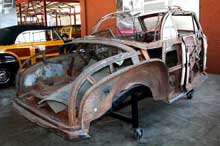At first glance this may look like a Ford convertible without its skin. That’s because it is a Ford convertible without its skin – the very heart and soul of a Ford Sportsman, actually. It’s tempting to assume the Sportsman was a response to Chrysler’s wonderful wood Town & Country, but actually the T&C and the Sportsman were developed nearly in parallel.
During World War II, Henry Ford II had a cut down Model A on which a wood runabout body was built at the factory for his Long Island beach house. HF II became rather fond of it and asked E.T. “Bob” Gregorie, the head designer, to come up with something similar for the postwar catalog. The result was the Sportsman, announced in September 1945, two months after the assembly lines resumed operation. Returning to full production, however, was a full-time task, so the first Sportsman wasn’t delivered until December.
The understructure was the same as the standard convertible body, with precision-jointed wood on top. The bodies were produced at the same Iron Mountain mills and assembly works in Michigan’s northern peninsula that had been supplying wood and building bodies for Ford station wagons since 1929.
The Sportsman had hydro-electric windows and top, and all had the postwar 59A-B 100 hp V8. Standard rear fenders and taillights wouldn’t work, so fenders from the sedan delivery were used instead, with 1941 taillights. Seats were faced in genuine leather, in a choice of red, tan or blue-gray, but any pairing with exterior colors was possible, leading to some unlikely combinations. The trunk was enormous, at the price of a very large and heavy lid. Early models had the red-accented trim of 1946 and early ’47, later ones the stylish translucent hood ornament.
There was also a Mercury Sportsman, in 1946 only. Just 205 were built before it was discontinued. The Ford Sportsman continued into 1947 and the 1948 model year, the last one built at the very end of 1947. Production, including the Mercurys, totaled just 3,692.
The cars shown here were part of the Nick Alexander Ford woodie collection, which was sold at auction on August 13th. Included were five Sportsman convertibles, one 1946 Ford and two from 1947. The single 1948 is believed to be the last Sportsman completed, and was owned by a San Diego school teacher for its first 35 years – until it was stolen from her garage. Pride of place, and high money for the sale ($368,500) was taken by this 1946 Mercury, interestingly with blackwall tires and neither radio nor heater. Mr. Alexander dislikes whitewalls, so few of his cars had them. He also prefers cars optioned the way they were first delivered, so some his cars had radio and heater, and others just one or the other.
All cars were sold at no reserve, the “lesser” convertibles bringing $214,500 to $275,000. In all, the collection of 51 cars grossed over $7 million. At sale’s end, many collectors went home with some excellent and correctly-restored cars.
The full story of the Ford and Mercury Sportsman convertibles, as well as the wood-bodied station wagons, can be found in Lorin Sorensen’s excellent book Famous Ford Woodies.
Full disclosure: As it says on my bio page, I neither appraise nor sell cars. I do, however, occasionally research and write about them, including the catalog for this sale.

